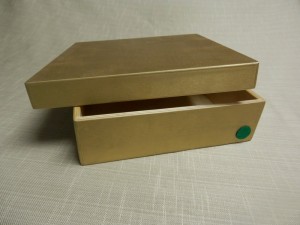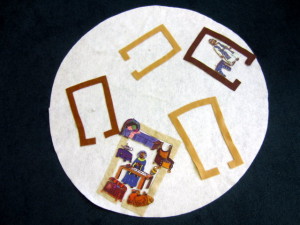Jul 29 | “In Gold Boxes,” (Sermon, July 27th, 2016)
Jesus said, “‘The kingdom of heaven is like treasure hidden in a field, which someone found and hid; then in his joy he goes and sells all that he has and buys that field.
‘Again, the kingdom of heaven is like a merchant in search of fine pearls; on finding one pearl of great value, he went and sold all that he had and bought it.”
Matthew 13:44-46
Today is all about parables, so I brought this parable box from our Godly Play set. This is how we teach the children at St. Philip’s about parables.
There are three main types of Godly Play stories. Each one has a script that should be followed as closely as possible, and each of the types of stories have specific features. There are Sacred Stories, Liturgical Action Stories, and Parables. The materials used say something about each story. Sacred Stories, which come from the narratives of Holy Scripture, often use upright and faceless figures to ground the children in the physical world, to remind them of the historical nature of the stories we tell.
Parables are different. They are presented with figures and objects that are flat with specifically drawn features to encourage the children to see them as stories told by Jesus rather than as living people. All parables in the Godly Play curriculum are presented in these boxes.
Why? I will show you, using the same words we use with the children.
“Hmmmm. What could this be? It is a box. I wonder if there could be a parable inside.
This box looks old. Parables are old. They are thousands of years old.
You know, this box also looks like a present. Parables are like presents. They were given to you before you were born.
This box is also the colour gold. Gold is valuable. Parables are also very valuable, maybe even more valuable than gold. There might be a parable inside.
And look, this box has a lid. It’s like a door that is shut. That is also like a parable. Sometimes it can be hard to open. If it is hard to open, don’t be discouraged. Come back to it again and again, and one day, it may open to you.â€
What follows this exploration is further exploration. Parables always have an underlay, usually a piece of felt. Depending on which parable, the felt is a different colour. We wonder with the children about what the underlay could really be. The underlay for the parable of the mustardseed looks kind of like a big yellow lemon. The one for the Sower is a long brown rectangle which usually looks like a chocolate bar to the children. The one for the Good Samaritan is a rough piece of brown burlap.
This parable box actually contains the Parable of the Great Pearl. Here is the underlay. The story is presented on top of it. The children are shown the merchant and the man who sells him the Great Pearl. It shows the journey of the merchant, searching and inspecting many pearls before finding the Great Pearl. When he inspects the other pearls, the storyteller should shake her head sadly, until the merchant comes to the right one, and the storyteller can finally nod.
The two men are placed inside rectangles of felt which likely symbolize houses. The merchant’s house is stuffed full with objects that he has purchased. The storyteller shows the merchant exchanging each of his household objects in three separate groups. Once again, she should shake her head at each offering: it is not enough. Finally, the merchant brings his bed and the house itself – the storyteller rolls up the rectangle of felt and presents it to the man at the table. Finally, the nod appears again, and the merchant is left with nothing except the pearl.
This is the end of the story. The children are asked the following wondering questions.
Today, they are my questions to you. I invite you to share whatever comes to your mind, and like we do with the children, I will repeat what I hear. We only repeat, without judgement. This is how we show the children that their opinions and beliefs about Scripture are valued and important. Sometimes it’s good to remind our big brothers and sisters in Christ of this truth too.
So, I wonder…
“I wonder if the person is happy with the great pearl.
I wonder what the merchant will do now.
I wonder why the seller would give up something as precious as the great pearl.
I wonder if the seller is happy with all his new things.
I wonder if the seller has a name.
I wonder if the merchant has a name.
I wonder what the great pearl could really be.
I wonder what could be so precious that you would be willing to exchange everything you have to get it.
I wonder if you’ve ever come close to the great pearl.
I wonder where this could really be.”
Once we have asked these questions, we tell the children that it is time for their work. Their work is to respond creatively to the story in some way. They can make art, retell the story with the pieces, or in our classes meet together and talk.
Of course we too have holy work to do. That is what we are leading them to understand.
So let us continue on with our holy work, and I will close with the words of our big brother in Christ, St. Augustine.
“Let us search for that which needs to be discovered, and into that which has been discovered. He whom we need to discover is concealed, in order to be sought after; and when found, is infinite, in order still to be the object of our search. … [H]ere let us always be seeking, and let our reward in finding put no end to our searching.â€

